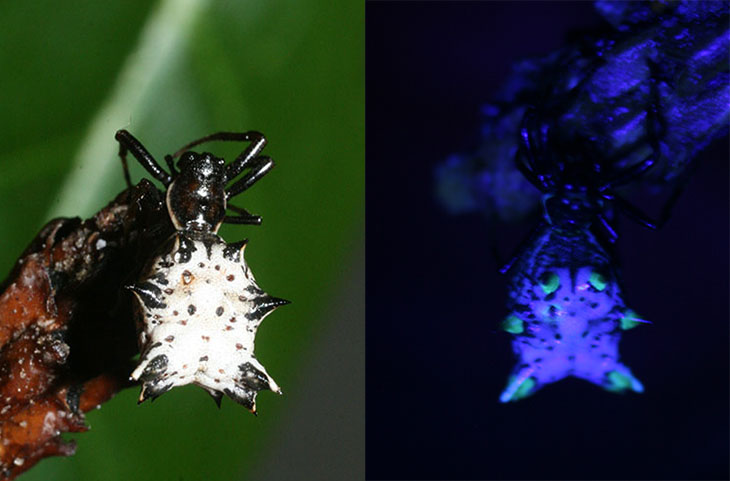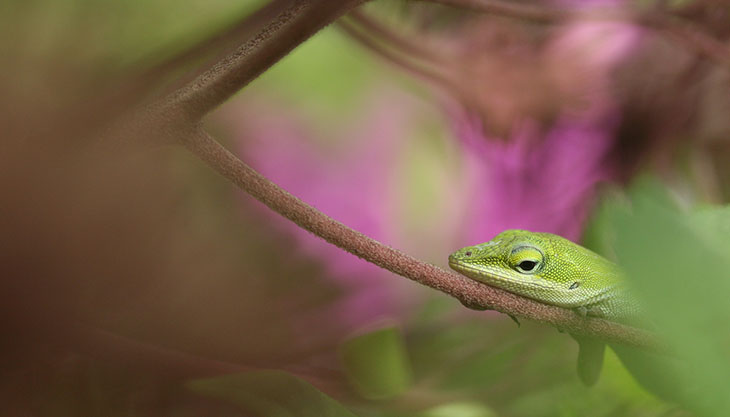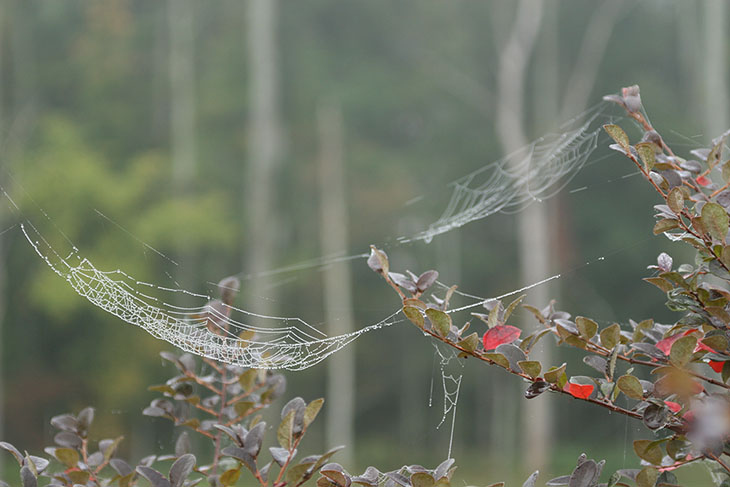
I realized, as I looked outside later in the morning than I should’ve, that we’d had an overnight fog and it still hadn’t cleared completely, so I trotted down to the pond to see if anything interesting could be done with it.
 The last time had been the busy season for the green treefrogs (Hyla cinerea) but they were considerably less abundant this time around; I think it’s late in the season for them, sometimes getting pretty chilly overnight and well past breeding time, so there’s less reason for them to be out. Also, I’ve seen a green heron (Butorides virescens) hanging out around the pond a few times, and they can be hell on the frogs, so that might have had something to do with it. Nevertheless, I found a few to work with, as well as some other items of photographic interest.
The last time had been the busy season for the green treefrogs (Hyla cinerea) but they were considerably less abundant this time around; I think it’s late in the season for them, sometimes getting pretty chilly overnight and well past breeding time, so there’s less reason for them to be out. Also, I’ve seen a green heron (Butorides virescens) hanging out around the pond a few times, and they can be hell on the frogs, so that might have had something to do with it. Nevertheless, I found a few to work with, as well as some other items of photographic interest.
As seen at top, conditions like this are marvelous for revealing just how many spiderwebs exist in any optimal area, and with a dark background, they can stand out quite well in images without the need for bright light. Consider, just for a moment, that the addition of the dew increases their weight by at least tenfold, likely far more – don’t look at me to produce any kind of serious numbers here, since I have no scale for smaller weights to speak of, much less one that could handle the micrograms that even a big web would weigh. If the spiders hang around, they’ll often get just as dew-covered, but this happens rarely; many species will abandon the web and crouch in their safe spot, usually off one upper corner of the web’s main support strands, when the dewpoint hits this strongly. The treefrogs, however, usually like this kind of weather, and if you want to see them during daylight hours, these are the days you aim for. This one posed on the leaf in a way sure to draw the most attention to itself, which must indicate that it’s a young adult female, right? Or does that only apply to humans?
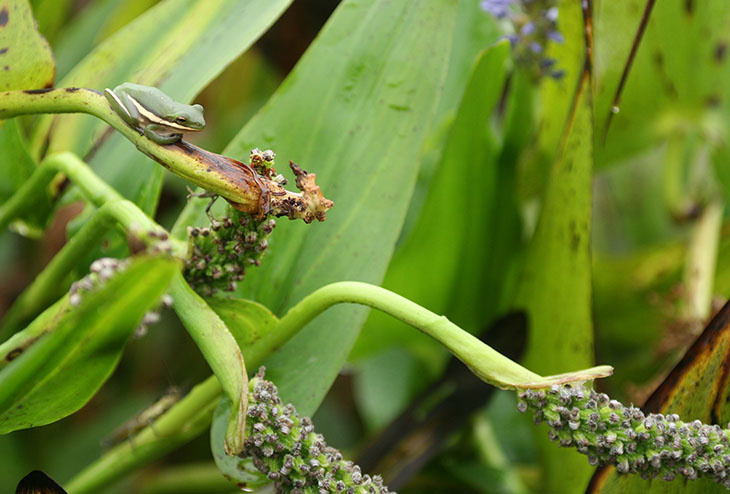
As far as images to provide impressions of the setting go, this one seems to be the most accurate; I like how the frog follows the same lines as the bent stalks (I entirely missed the grasshopper in the background until just now, though.) Yet there are quite a few different approaches that can be taken for subjects like this, and I recommend trying several when given the opportunity.
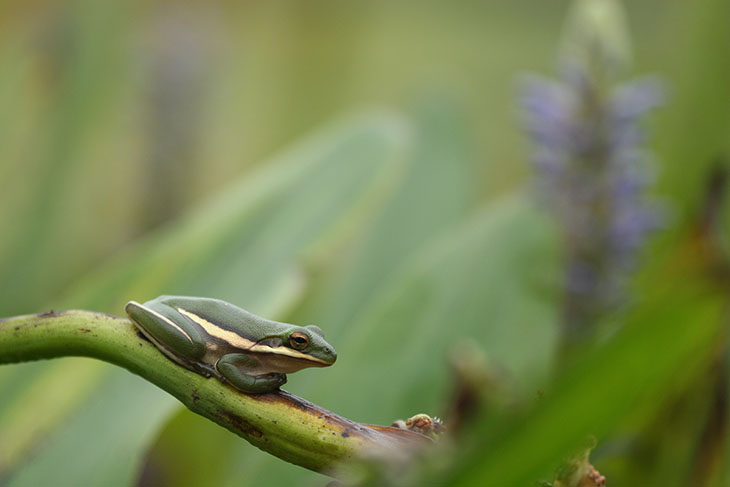
Same frog, different angle and framing – the frogs don’t often perch near the blue flower spikes that pickerelweed produces, so any time I can work an angle that includes them, I’m happy.
This pose is common, reminiscent of how cats often sit, but it likely serves a more useful purpose. Treefrogs rely on the moisture and tactile control of their footpads to cling to vertical and even slick surfaces, so tucking in their legs in this manner helps keep the pads from drying out. It also makes them appear to be a porcelain sculpture – no limbs, just creases. This was shot with an 80mm lens; any closer and I likely would have scared it off.
While wending my way through the pickerelweed growing in the shallows at the edge of the pond, and before that the tall weeds and underbrush bordering the water, I encountered a few more spiders (naturally.) Two massive Argiope aurantias had spun webs across my path at waist height, both of which being discovered when only a half-meter away (they had cleverly positioned their brilliant yellow backs in the opposite direction from my approach,) and one other specimen, a large six-spotted fishing spider (Dolomedes triton,) was found perched on the weeds at the same height.

The dew almost obscured her white abdominal spots (not the ones from the species name, though – those are on the belly instead,) and she remained placidly unconcerned with my close approach, unusually so. I used the blade of my pocketknife to nudge her gently, and she remained in position, idly fending off the nudges with her forelegs before changing position only slightly – very unlike the species. When I switched my own position to provide a better photographing angle, I suddenly realized why she was sticking to her perch so adamantly.
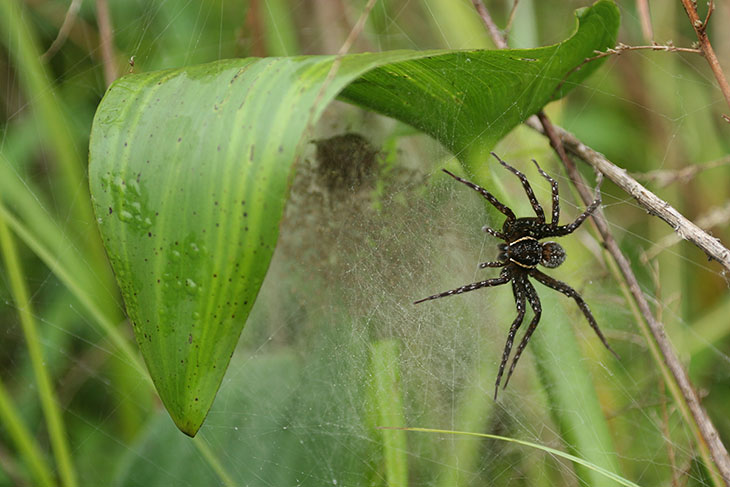
I had approached from the opposite side, and the arched pickerelweed leaf had shielded my view of the cluster web. Fishing spiders don’t really make webs, since they’re free-roaming (and swimming) hunting spiders, but it seems they do when the old biological alarm clock chimes. I was disturbing the proud mother of several hundred little fishers, hatched from the egg sac hidden in the protective webbing, but not yet venturing out on their own – that’s what the out-of-focus haze under the leaf consists of.
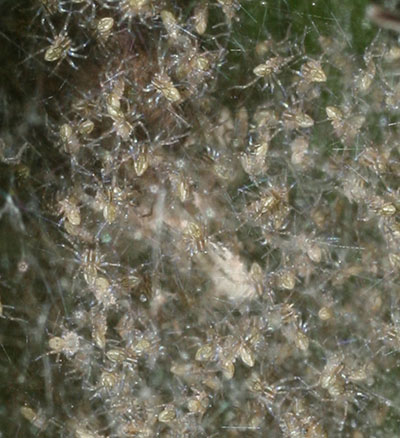 Switching focus to the younguns and using the flash provided a little better view, but not a lot – there were still countless strands of silk in the way to prevent really sharp focus. Still, it’s enough to prove that I wasn’t just seeing chaff or something.
Switching focus to the younguns and using the flash provided a little better view, but not a lot – there were still countless strands of silk in the way to prevent really sharp focus. Still, it’s enough to prove that I wasn’t just seeing chaff or something.
For many spider species, the mother hangs around and runs interference while the newborns spend time in a protected area; to the best of my knowledge, this is all she does, since food sources appropriate for the minuscule babies would be near-impossible for the mother to catch, especially in quantity. A few spider species catch prey that they tear open for the young, while a couple of others actually produce fluid from their mouths that the babies can eat, but I don’t believe either of these traits applies to Dolomedes. This leaves the question of why the young remain in a protective web and under the mother’s watchful eyes for a period of time, and as yet I cannot answer that.
By the way, mama measured roughly 25mm in body length, over 60 counting the leg spread – the babies were 5mm in leg spread at the most. On the previous frog-hunting trip, the fishing spider male that I photographed was in almost the exact same area – it’s possible that I now have images of the entire family. I should go back for closer portraits of the babies and see if there’s any resemblance…
I’ll close with another frame giving an even greater impression of the conditions, new branches on the same species of bush as that supporting the webs in the opening shot. I wish I’d gotten out when the fog was thick, but I still need to pin down a few prime locations that would look the best in such weather. I haven’t found any decrepit abandoned houses nearby yet…
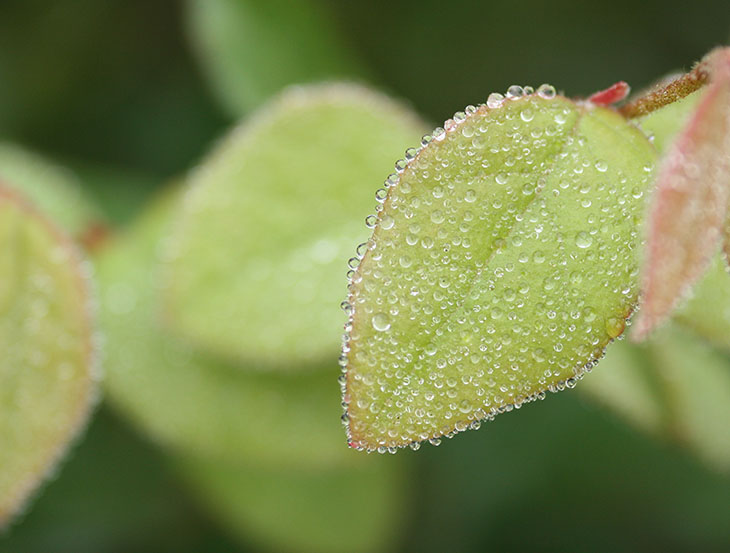




















































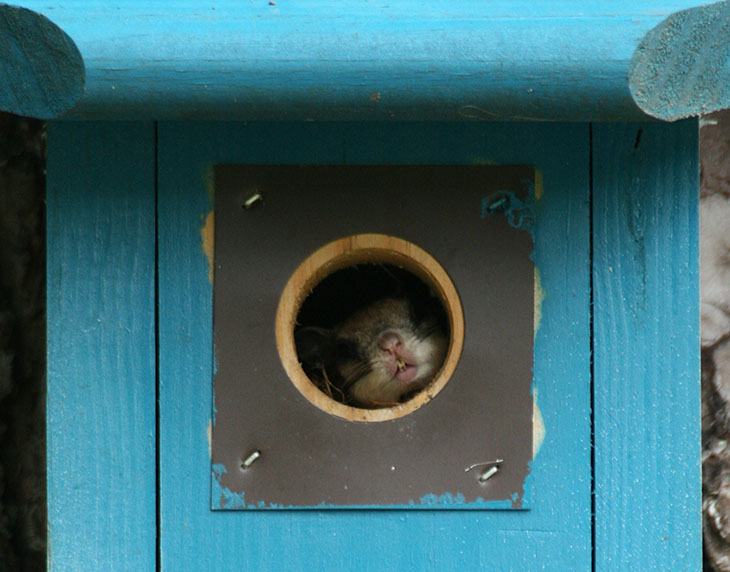
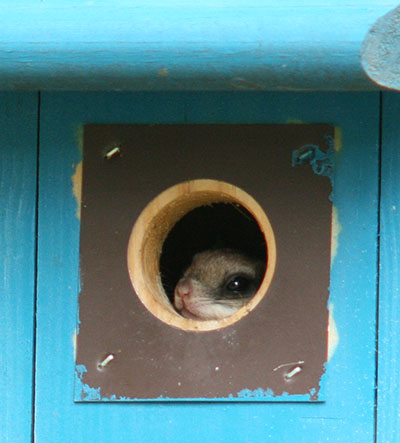 To say I was delighted would be putting it mildly. While I’ve known for decades that they lived in this area, I’ve seen just one flying squirrel in the wild, and that was in downtown Savannah, Georgia, while we waited at dusk for the ghost tour to begin. Now, I’ve handled them while doing rehab, and even have a
To say I was delighted would be putting it mildly. While I’ve known for decades that they lived in this area, I’ve seen just one flying squirrel in the wild, and that was in downtown Savannah, Georgia, while we waited at dusk for the ghost tour to begin. Now, I’ve handled them while doing rehab, and even have a 
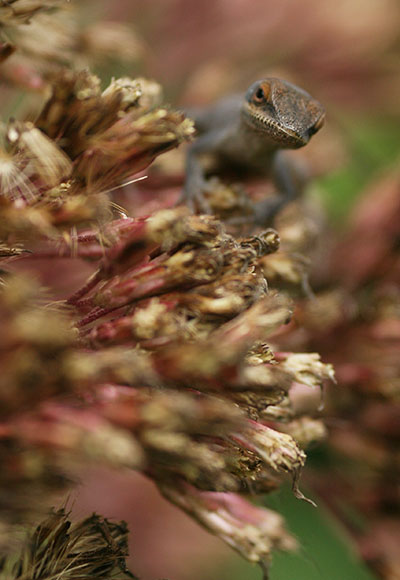 You may well ask, what, exactly, is that title supposed to mean? Well, it refers to the idea that I don’t really do
You may well ask, what, exactly, is that title supposed to mean? Well, it refers to the idea that I don’t really do 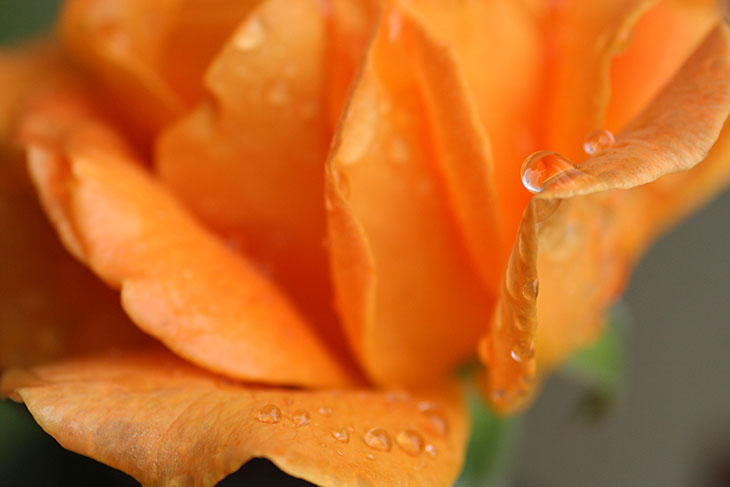
 I have no idea what these are, but those sure look like grape leaves. A quick search on “blue grapes” didn’t turn up any matches, but I like the colors all the same. Actually, they look extremely tasty to me, and if they’d ever made a children’s cereal that looked like that I probably would have eaten nothing else in my youth (maybe not even now,) but I’m also not fooled by it. Found in a nature preserve brimming with birds, I was going to say these were suspiciously untouched, but there are a few empty stems there, so now I’m not too sure. If anyone wants to find out for themselves, stop by and I’ll take you over there – if you survive, I’ll try a few myself and post the results.
I have no idea what these are, but those sure look like grape leaves. A quick search on “blue grapes” didn’t turn up any matches, but I like the colors all the same. Actually, they look extremely tasty to me, and if they’d ever made a children’s cereal that looked like that I probably would have eaten nothing else in my youth (maybe not even now,) but I’m also not fooled by it. Found in a nature preserve brimming with birds, I was going to say these were suspiciously untouched, but there are a few empty stems there, so now I’m not too sure. If anyone wants to find out for themselves, stop by and I’ll take you over there – if you survive, I’ll try a few myself and post the results.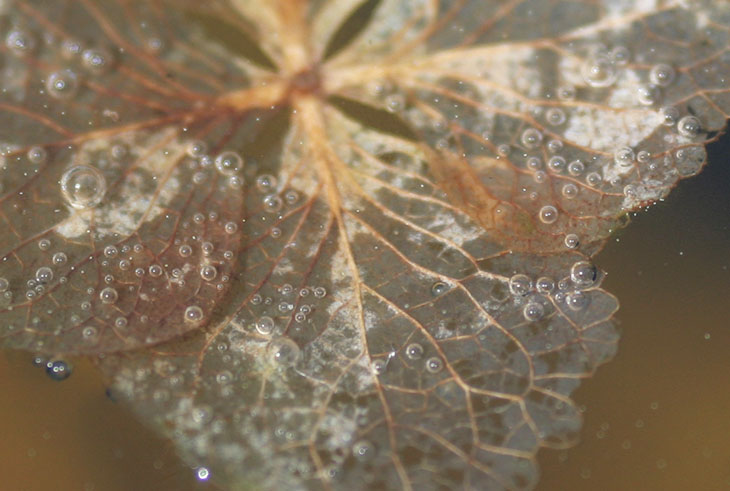
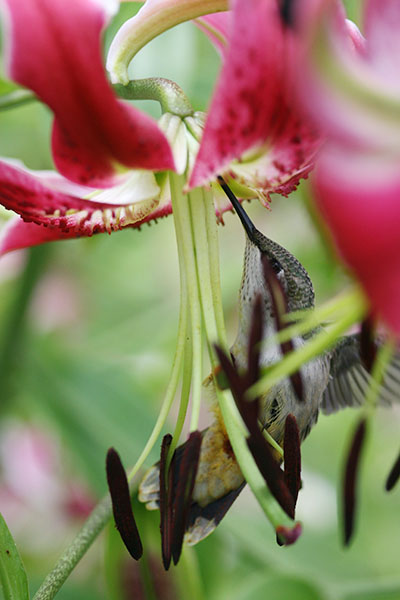 At the botanical garden one day, a ruby-throated hummingbird (Archilochus colubris) that wasn’t doing very well took a sip from a lily while I was nearby. Ideally, of course, you want a clearer view without another bloom in the way, but I kind of liked the idea that this was an almost-obscured perspective, a sneak peek at the bird. The yellow feathers near the tail, however, aren’t normal, but a sign of discharge, part of the reason why I said she wasn’t doing very well – the other was the tendency to perch and fluff out her feathers on a perfectly warm, dry day. Birds that are ill often do this to conserve their body heat and divert their resources towards areas where they’re needed more. Something was amiss, and I have a lot of very detailed frames of her while she simply sat on branches, not quite oblivious to close approaches, but certainly a lot more tolerant of such than is typical.
At the botanical garden one day, a ruby-throated hummingbird (Archilochus colubris) that wasn’t doing very well took a sip from a lily while I was nearby. Ideally, of course, you want a clearer view without another bloom in the way, but I kind of liked the idea that this was an almost-obscured perspective, a sneak peek at the bird. The yellow feathers near the tail, however, aren’t normal, but a sign of discharge, part of the reason why I said she wasn’t doing very well – the other was the tendency to perch and fluff out her feathers on a perfectly warm, dry day. Birds that are ill often do this to conserve their body heat and divert their resources towards areas where they’re needed more. Something was amiss, and I have a lot of very detailed frames of her while she simply sat on branches, not quite oblivious to close approaches, but certainly a lot more tolerant of such than is typical.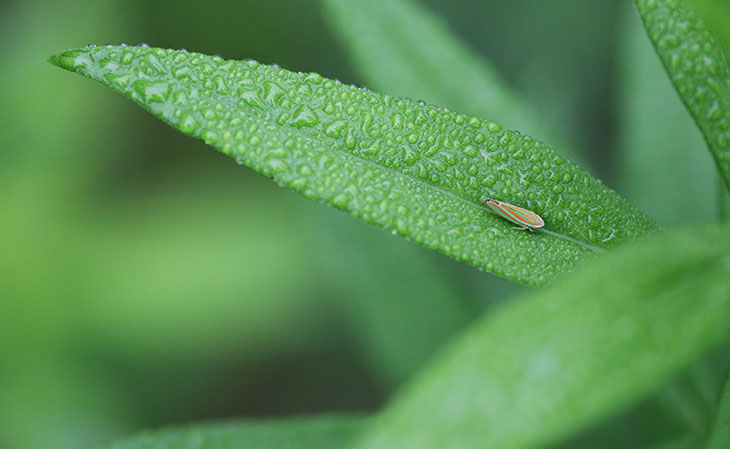
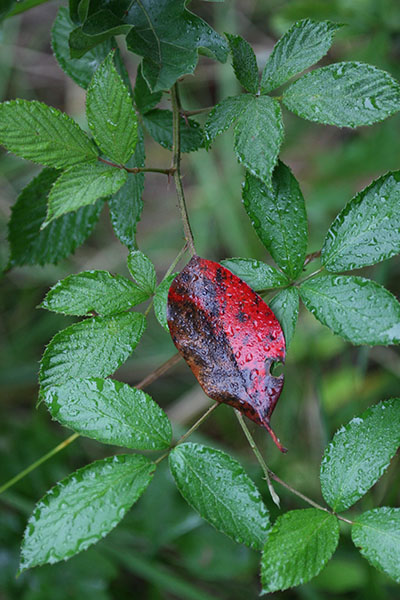 Both of these images were taken on the same morning, after a deep overnight fog that I failed to take advantage of. Above, a lone Graphocephalo genus leafhopper aligns itself with the shape of the leaf yet somehow manages not to be inconspicuous – it still attracts less attention than the lone red leaf that fell across its healthier brethren. I know you were waiting to see if I could make it ten days without posting images of some insect, but it was not to be. Let it go a little longer – the winter months will be hard on me, and I’m already doing too many ‘studio’ shots because the pickings are leaner. The other day a small male mantis appeared on the porch, but only allowed a couple of half-ass frames before flying off in desperation. I really need to live in a rainforest someplace…
Both of these images were taken on the same morning, after a deep overnight fog that I failed to take advantage of. Above, a lone Graphocephalo genus leafhopper aligns itself with the shape of the leaf yet somehow manages not to be inconspicuous – it still attracts less attention than the lone red leaf that fell across its healthier brethren. I know you were waiting to see if I could make it ten days without posting images of some insect, but it was not to be. Let it go a little longer – the winter months will be hard on me, and I’m already doing too many ‘studio’ shots because the pickings are leaner. The other day a small male mantis appeared on the porch, but only allowed a couple of half-ass frames before flying off in desperation. I really need to live in a rainforest someplace…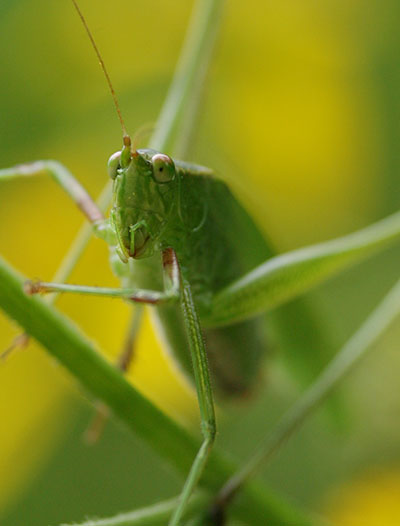 And so I leave you with a katydid portrait, because everyone should have one, don’t you think? Once again shooting wide-open in poor light, the background colors set up a pleasant but low-key contrast to the orthopteran, who adopted an insect-of-action pose for the shot – some species just can’t act natural in front of a camera. One antenna is of course rather visible, but the other droops down in an arc over the head, and believe it or not, I shifted position and timed it to be that way – I’ve been burned many times before on antennae falling in front of an insect’s eyes and ruining the shot. It’s one of those stupid things you never imagine you’d have to think about when chasing macro photos, but there you go, a little tip from your Uncle Al. Who’s wondering why you keep forgetting his birthday, not to mention Uncle’s Day…
And so I leave you with a katydid portrait, because everyone should have one, don’t you think? Once again shooting wide-open in poor light, the background colors set up a pleasant but low-key contrast to the orthopteran, who adopted an insect-of-action pose for the shot – some species just can’t act natural in front of a camera. One antenna is of course rather visible, but the other droops down in an arc over the head, and believe it or not, I shifted position and timed it to be that way – I’ve been burned many times before on antennae falling in front of an insect’s eyes and ruining the shot. It’s one of those stupid things you never imagine you’d have to think about when chasing macro photos, but there you go, a little tip from your Uncle Al. Who’s wondering why you keep forgetting his birthday, not to mention Uncle’s Day… This is just a couple of quick comments – nothing really thought-provoking. I say that as if it’s different from the rest of the content…
This is just a couple of quick comments – nothing really thought-provoking. I say that as if it’s different from the rest of the content…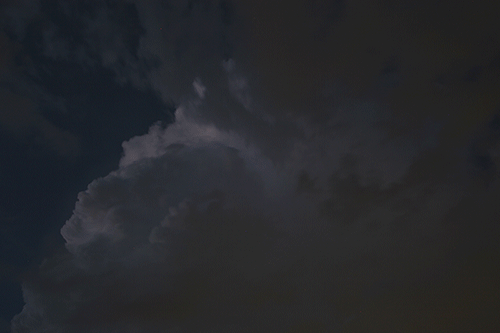 While waiting on those responses (I imagine it will be a while,) I’ll leave you with an animation made from twelve consecutive frames of that storm. These were all ten-second exposures with roughly ten seconds or less in between, so overall this spans just under three minutes – you’ve seen cropped versions of two of these frames in that earlier post. Right after the last frame seen here, I switched camera position, so the big ground strike – which occurred three frames later – could not be included in the gif (pronounced “hal-a-PEEN-yo”) without drastic cropping. Still, this does a great job of illustrating the twisting and depth of the clouds, and the activity therein.
While waiting on those responses (I imagine it will be a while,) I’ll leave you with an animation made from twelve consecutive frames of that storm. These were all ten-second exposures with roughly ten seconds or less in between, so overall this spans just under three minutes – you’ve seen cropped versions of two of these frames in that earlier post. Right after the last frame seen here, I switched camera position, so the big ground strike – which occurred three frames later – could not be included in the gif (pronounced “hal-a-PEEN-yo”) without drastic cropping. Still, this does a great job of illustrating the twisting and depth of the clouds, and the activity therein.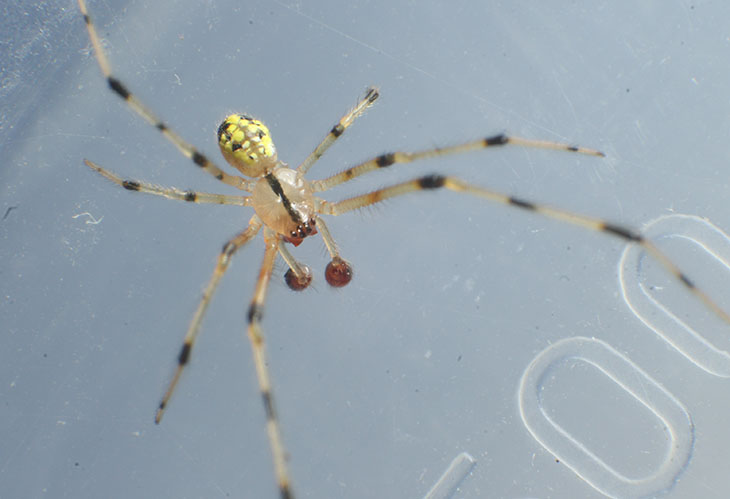
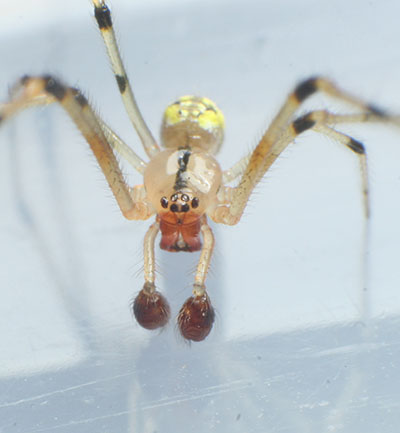 My specimen is small, as the male spiders often are, this one measuring 8mm in body length at best (I forgot to confirm when I could.) I went in for a face shot because, hey, anyone can do an overhead full-body pic, plus I was, as I said, testing out the lighting. After I unloaded the memory card, I noticed (besides the eye reflections) that the chelicerae appeared somewhat distinctive, and since I had not yet identified the species, I decided I’d like a closer look. He was still sitting where I’d taken these shots and left him, which was on a graduated container sitting on the porch (containing other arthropods, if you must know, ones not half as interesting as this one,) so it was an easy matter to capture him and go for slightly more controllable conditions.
My specimen is small, as the male spiders often are, this one measuring 8mm in body length at best (I forgot to confirm when I could.) I went in for a face shot because, hey, anyone can do an overhead full-body pic, plus I was, as I said, testing out the lighting. After I unloaded the memory card, I noticed (besides the eye reflections) that the chelicerae appeared somewhat distinctive, and since I had not yet identified the species, I decided I’d like a closer look. He was still sitting where I’d taken these shots and left him, which was on a graduated container sitting on the porch (containing other arthropods, if you must know, ones not half as interesting as this one,) so it was an easy matter to capture him and go for slightly more controllable conditions.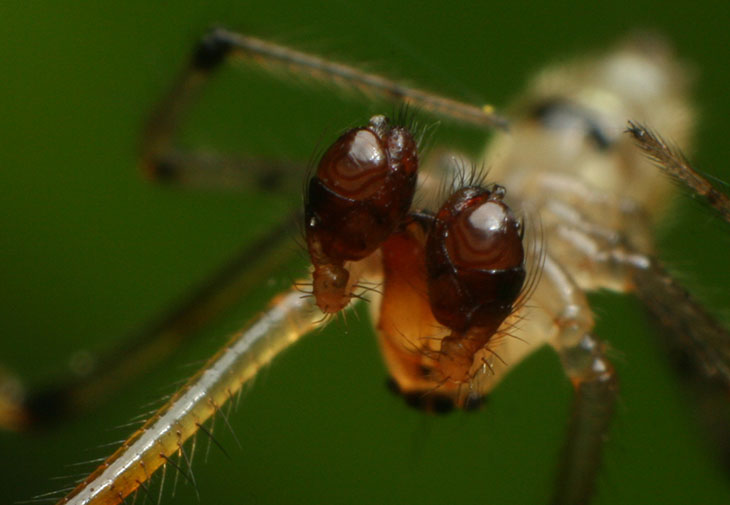

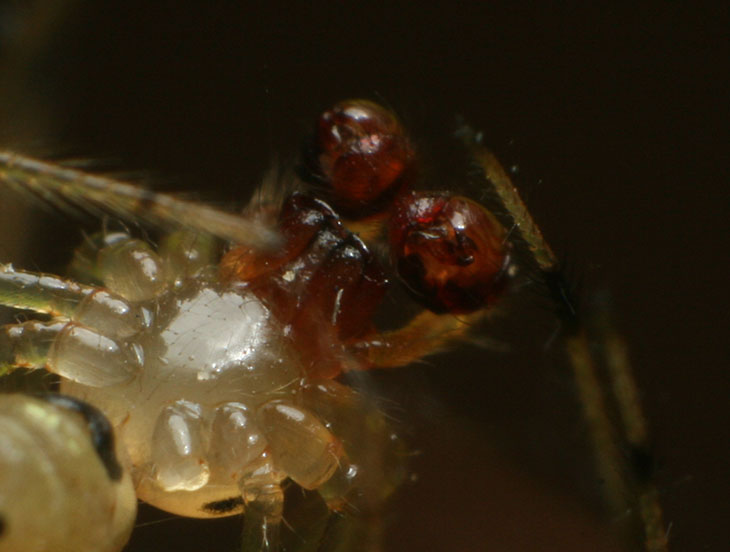

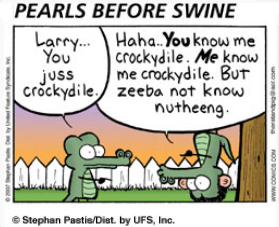
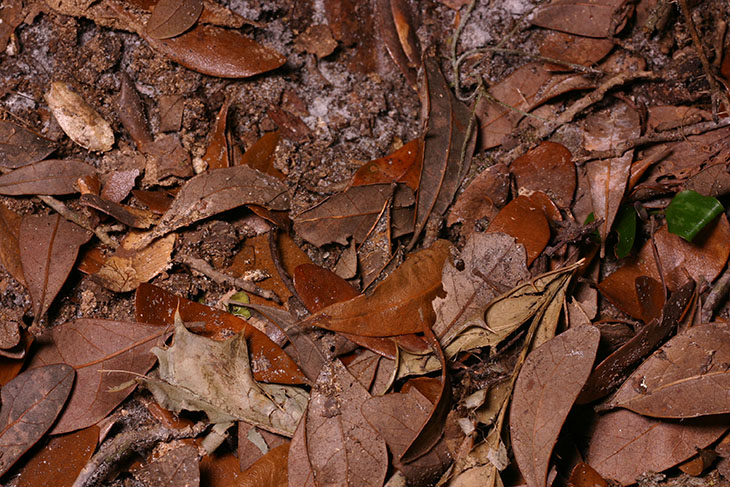
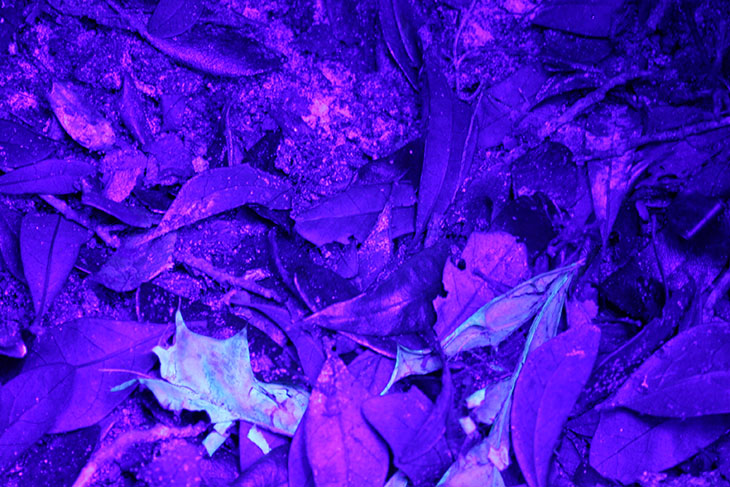
 Now we get to fluorescence. Fluorescence (and phosphorescence, a close relative) is a curious trait where a substance absorbs energy that it then re-emits as visible photons. In cases of UV fluorescence, possessed by some substances, some arthropods, and even some minerals, the UV photons are absorbed into the substance as greater activity in the atom, electrons jumping to a higher energy state. Almost immediately, they drop back down to their ‘normal’ state and re-emit this energy, but at a different level, thus producing a different wavelength, one that we can see. So it’s not like the normal situation we find ourselves in every day, where photons simply bounce off of an object and reach our eye, but a trade, where objects keep the photon energy and exchange it for photons that we can see – a chemical ‘currency exchange’ system.
Now we get to fluorescence. Fluorescence (and phosphorescence, a close relative) is a curious trait where a substance absorbs energy that it then re-emits as visible photons. In cases of UV fluorescence, possessed by some substances, some arthropods, and even some minerals, the UV photons are absorbed into the substance as greater activity in the atom, electrons jumping to a higher energy state. Almost immediately, they drop back down to their ‘normal’ state and re-emit this energy, but at a different level, thus producing a different wavelength, one that we can see. So it’s not like the normal situation we find ourselves in every day, where photons simply bounce off of an object and reach our eye, but a trade, where objects keep the photon energy and exchange it for photons that we can see – a chemical ‘currency exchange’ system.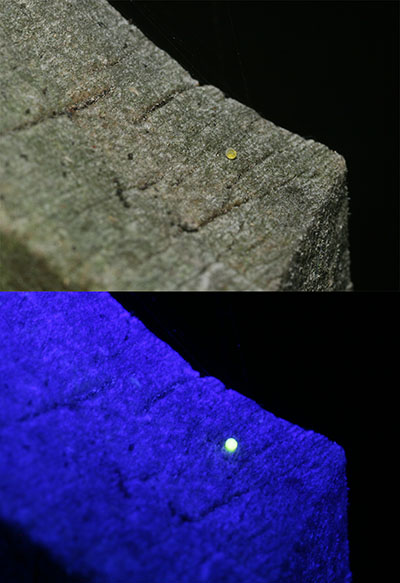 Anyway, as I was typing all this I realized that I hadn’t tried out the UV light around the new yard yet. I had done a little exploring in different areas around the old place, finding very little of interest, but so far hadn’t checked out this area. I knew there were no scorpions to find, but what about other arthropods? Some macro photographers,
Anyway, as I was typing all this I realized that I hadn’t tried out the UV light around the new yard yet. I had done a little exploring in different areas around the old place, finding very little of interest, but so far hadn’t checked out this area. I knew there were no scorpions to find, but what about other arthropods? Some macro photographers, 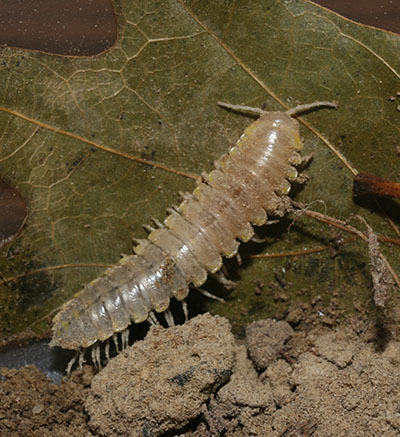 At one point, I found the juvenile form of an Apheloria virginiensis montana, a large black & yellow centipede that’s not hard to find around here – see
At one point, I found the juvenile form of an Apheloria virginiensis montana, a large black & yellow centipede that’s not hard to find around here – see 
